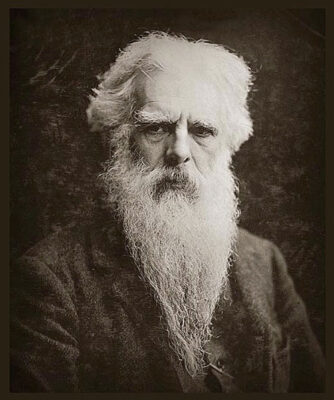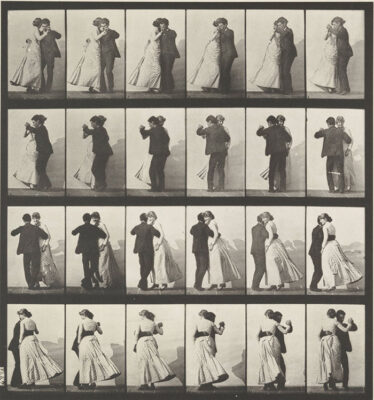A pioneering motion picture and the world’s first dance movie- by Eadweard Muybridge. Now brought to life with AI neural networks. “Man and Woman Dancing a Waltz 1884”

The Roundhay Garden Scene” (1888) and later the Lumiere brothers “Arrival of a Train at La Ciotat”(1896) were not in fact the first motion pictures.
Eadweard Muybridge was creating the first motion pictures in the late 1870’s and early 1880’s.
Using chronophotography, he first captured time in motion over 140 years ago in a groundbreaking project. Muybridge commenced “Animal Locomotion (1887)” in 1878 and completed his project at Penn University between 1884 and 1885.

Watch these original frames now in all their glory. Using AI upscaling, colorization and frame interpolation. . Muybridge himself never got to see his movies in this way.
Man and Woman Dancing a Waltz – c.1884 | AI Enhanced [60 fps]
I’ve chosen Plate 197 – Man and Woman dancing a Waltz. The name of the woman is Blanche Eplar. The man may have been one of Muybridge’s staff drafted in for the session. Most likely made in 1884.

EADWEARD MUYBRIDGE – TIMELINE
Muybridge first came to fame in 1878 when he published a photographic sequence called “The Horse in Motion.” In 2012 they formed a Google doodle to commemorate the 182nd anniversary of Muybridge’s birthday.

Muybridge presented the earliest known motion picture exhibition in 1880 at the California School of Fine Arts. His audience did not get to see the photographic sequence in motion, but rather an animated silhouette. These animations were painstakingly painted on to glass discs and viewed using a Zoopraxiscope – Muybridges invention. This odd machine was a precursor of the movie projectors.
1884 – The First Motion Pictures Studio

In 1883, the University of Pennsylvania, with remarkable foresight, offered Muybridge funds. These helped him build a proper outdoor studio on their premises.
Muybridge commenced his historic photo sessions early in 1884..
The funds paid for extra cameras, staff and human models. Many of the human models were students attending the University. The local zoo provided the animals. This was conveniently next door to the university.


The groundbreaking collection of 781 plates was finally published in 1887. Called “Animal Locomotion: an Electro-Photographic Investigation of Connective Phases of Animal Movements.”
Not the catchiest of titles for the worlds first motion pictures. You can view the Muybridge plates in all their glory on the internet archive.
1887 – The First Motion Pictures
Copies of the original plates were sold in sets of 100 for $100. This ensured that only the wealthy or institutions had access. The uptake was a financial disaster for Muybridge. In 1889, he took his study on a global lecture tour, projecting his motion pictures with his Zoopraxiscope.
The reviews were ecstatic such as this one from New York’s The Nation.

“Here, for the first time, human eyes may see just how the human body moves. Graceful enough to delight the soul of Raphael. One is filled with wonder at the power of the eye, that saw movement that has waited till now for proof of their verity.”
The Invention of Film – A Short history
Others would soon eclipse Muybridge. Etienne-Jules Marey, a colleague from France, advanced what he coined “chronophotography” using a single camera.
Louis le Prince ( Roundhay Garden Scene 1888). Also William Friese-Greene, Georges Demenÿ and Birt Acres would all make advances in movie camera design. Eastman-Kodak celluloid 35mm film would become the standard capture medium from 1890.
In 1884 – Thomas Edison’s Kinetograph ( designed by W. K. L. Dickson) captured a sneeze. Edison declared it to be the worlds first movie camera.
In 1895 The Lumiere Brothers truly launched cinema with the Cinematograph. It was inspired by all the preceding inventions. It both filmed and projected the results. Their landmark early actuality films from 1895 onward revolutionized film.
Modern movie making ironically uses Muybridge’s techniques. Time Slice Photography was first seen in the movie The Matrix (1999.) Muybridge died on 8 May 1904 in Kingston upon Thames of prostate cancer at the home of his cousin Catherine Smith. His remains were interred in a grave at Woking in Surrey. On the grave’s headstone his name is misspelled as “Eadweard Maybridge”.
That’s all ! © Glamourdaze.com
